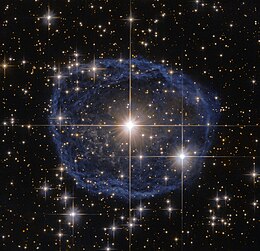This is an old revision of this page, as edited by Arianewiki1 (talk | contribs) at 12:34, 22 April 2016 (Undid revision 716565116 by Lithopsian (talk) Either discuss this on the talk page, or your edits are meaningless.). The present address (URL) is a permanent link to this revision, which may differ significantly from the current revision.
Revision as of 12:34, 22 April 2016 by Arianewiki1 (talk | contribs) (Undid revision 716565116 by Lithopsian (talk) Either discuss this on the talk page, or your edits are meaningless.)(diff) ← Previous revision | Latest revision (diff) | Newer revision → (diff)
WR 31a is a Wolf-Rayet star in the southern constellation of Carina that is surrounded by an expanding optical blue bubble nebula Some media sources have wrongly claimed this deep-sky object was recently discovered by the Hubble Space Telescope, but this nebula was originally found by Ellen Dorrit Hoffleit in 1953 and designated as the planetary nebula Hf 39. Other planetary nebula catalogue names included, He 3-319, ESO 128-18, and Wray 15-682.
Since 2013, the object has been considered not a planetary nebula but rather, an expanding gas shell, formally classified as a Wolf–Rayet nebula or WR nebula. Its observed expansion velocity is 365 km.s, estimated to be some 2.4 parsecs across.
Its central highly luminous star (TYC 8928-1166-1) is invisible to the naked-eye, shining at 10.85V magnitude, whose spectral type is WN11h. Mass of the central star is estimated to be at least 20 times that of the Sun, and it will likely become a supernova type II event in the future. Distance is estimated to be about 9,200 parsecs or 30,000 light-years.
References
- "Hubble's Blue Bubble". NASA. Retrieved 1 March 2016.
- "Hubble Captures "Blue Bubble' Star - 20 Times Bigger, a Million Times Brighter than the Sun's". Inquisitr. Retrieved 2 March 2016.
- ^ "VizieR". CDS. Retrieved 2 March 2016.
- Frew, D. J.; Bojicic, I. S.; Parker, Q. A. (2013). "A catalogue of integrated Hα fluxes for 1258 Galactic planetary nebulae". Monthly Notices of the Royal Astronomical Society. 431: 2. Bibcode:2013MNRAS.431....2F. doi:10.1093/mnras/sts393.
{{cite journal}}: CS1 maint: unflagged free DOI (link) - ^ Toalá, J. A.; Guerrero, M. A.; Ramos-Larios, G.; Guzmán, V. (2015). "WISE morphological study of Wolf-Rayet nebulae". Astronomy & Astrophysics. 578: A66. arXiv:1503.06878v1. doi:10.1051/0004-6361/201525706.
- "SIMBAD". CDS. Retrieved 2 March 2016.
- "Blue bubble in Carina". NASA. Retrieved 2 March 2016.